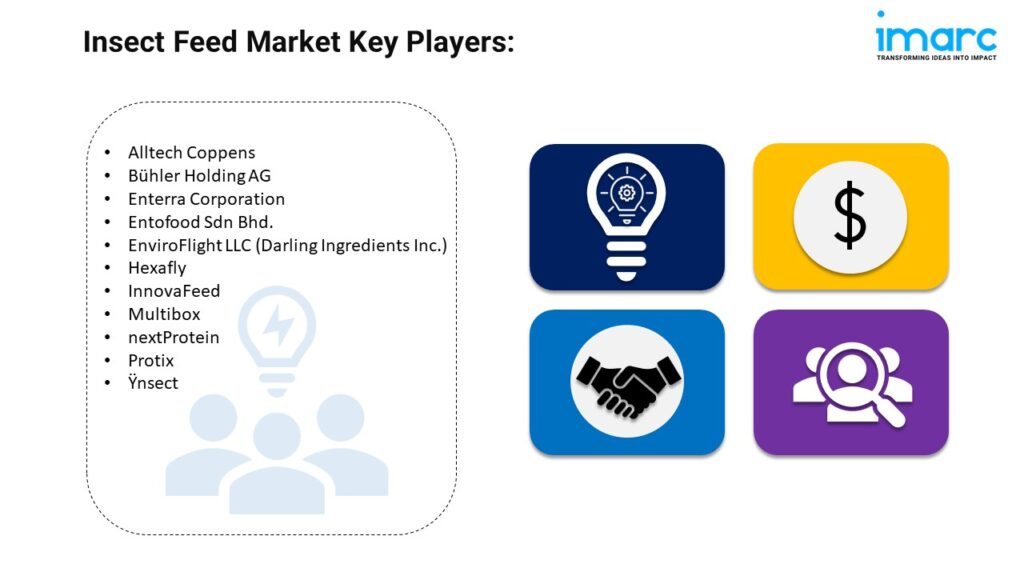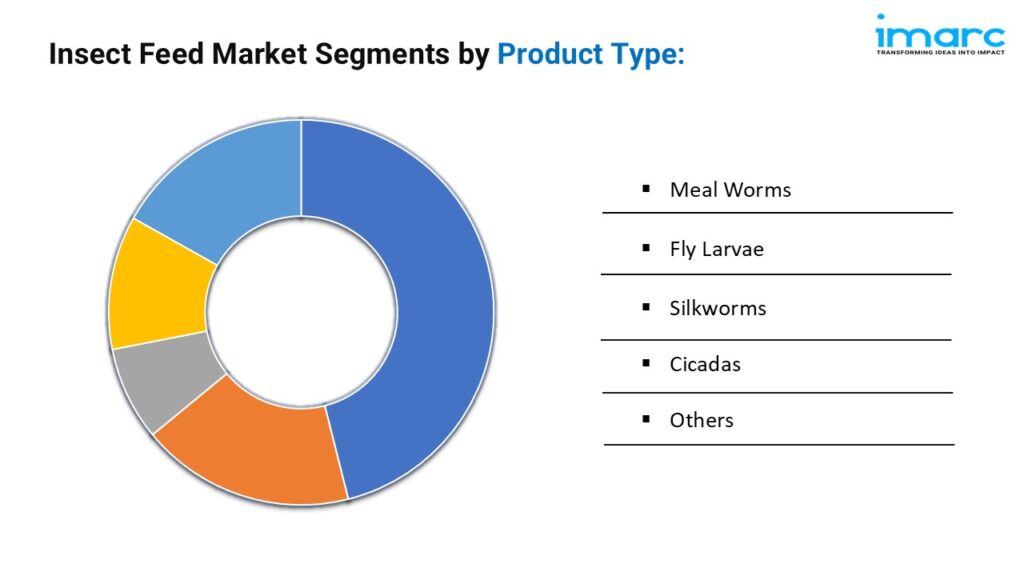Market Overview:
The insect feed market is experiencing rapid growth, driven by rising demand for sustainable protein sources, supportive regulatory frameworks, and increasing investments in insect farming. According to IMARC Group’s latest research publication, “Insect Feed Market Report by Product Type (Meal Worms, Fly Larvae, Silkworms, Cicadas, and Others), Application (Aquaculture, Pig Nutrition, Poultry Nutrition, Dairy Nutrition, and Others), and Region 2025-2033”, the global insect feed market size reached USD 1,073.8 Million in 2024. Looking forward, IMARC Group expects the market to reach USD 2,450.2 Million by 2033, exhibiting a growth rate (CAGR) of 9.6% during 2025-2033.
This detailed analysis primarily encompasses industry size, business trends, market share, key growth factors, and regional forecasts. The report offers a comprehensive overview and integrates research findings, market assessments, and data from different sources. It also includes pivotal market dynamics like drivers and challenges, while also highlighting growth opportunities, financial insights, technological improvements, emerging trends, and innovations. Besides this, the report provides regional market evaluation, along with a competitive landscape analysis.
Download a sample PDF of this report: https://www.imarcgroup.com/insect-feed-market/requestsample
Our report includes:
- Market Dynamics
- Market Trends and Market Outlook
- Competitive Analysis
- Industry Segmentation
- Strategic Recommendations
Growth Factors in the Insect Feed Market
- Rising Demand for Sustainable Protein Sources
The global push for sustainable protein is a major driver for the insect feed industry. Traditional livestock feed like soy and fishmeal requires vast land and water, but insect feed offers an eco-friendly alternative. Insects like black soldier flies and mealworms need minimal space and can convert organic waste into high-protein feed, reducing environmental strain. Producing 1 ton of insect protein uses up to 80% less land than soy production. Companies like Protix have raised investments, such as €50 million in January, to scale up insect farming for aquaculture and poultry. This demand is fueled by growing global meat consumption, which has surged by millions of tons annually, pushing farmers to seek nutrient-rich, sustainable feed options to meet livestock needs.
- Supportive Regulatory Frameworks
Governments worldwide are easing regulations to support insect feed adoption, boosting market growth. The European Union has set standards for insect-based feed, approving species like black soldier flies for aquaculture and poultry. In North America, Canada’s government backs research into insect farming, funding startups like Enterra Feed. These policies reduce barriers and encourage innovation. The FDA’s approval of dried black soldier fly larvae for poultry feed has opened new markets in the U.S., where companies like EnviroFlight are expanding production. Insect feed emits up to 50% less greenhouse gases than traditional feed, aligning with global sustainability goals. Such frameworks are encouraging farmers to adopt insect feed, driving industry expansion across regions like Europe and Asia-Pacific.
- Increasing Investments in Insect Farming
Investment in insect feed production is skyrocketing, fueling industry growth. Venture capital firms and corporations are pouring funds into innovative startups to meet rising demand. Tyson Foods partnered with Protix, investing in a facility to produce millions of pounds of insect protein annually. InnovaFeed secured funding to build large-scale mealworm farms in North America. These investments are driven by the high feed conversion ratio of insects, where 1 kg of feed can yield up to 9 kg of insect biomass. This efficiency attracts investors seeking sustainable solutions. Companies like Ynsect are leveraging these funds to enhance automated farming technologies, reducing costs and scaling production to meet the growing needs of aquaculture and livestock industries globally.
Three Key Trends in the Insect Feed Market
- Integration with Circular Economy Models
Insect feed is gaining traction as a cornerstone of circular economy models, turning waste into valuable protein. Insects like black soldier flies can transform food and agricultural waste into nutrient-rich feed, with 1 ton of organic waste yielding up to 300 kg of insect biomass. Companies like AgriProtein are partnering with waste management firms to create closed-loop systems, reducing landfill waste while producing feed. In Asia-Pacific, where food waste is a growing issue, startups like Loopworm are scaling up operations to process millions of tons of organic waste annually. This trend appeals to environmentally conscious industries and governments pushing for sustainability, with initiatives in countries like Thailand promoting insect farming as a waste-to-protein solution, boosting economic and environmental benefits.
- Expansion in Aquaculture Applications
The aquaculture sector is increasingly adopting insect feed as a sustainable alternative to fishmeal, which is often sourced from overfished waters. Insect feed, rich in protein and amino acids, supports healthier fish and shrimp growth, with studies showing up to 20% faster growth rates in tilapia fed with insect meal. In Egypt, a top tilapia producer, startups like Proteinia are innovating with black soldier fly-based feed to meet aquafeed demand. Companies like InnovaFeed have launched insect-fed fish lines, with products hitting markets in Europe. This trend is driven by the global aquaculture industry’s need for eco-friendly feed, with over 60% of producers exploring insect-based solutions to reduce environmental impact and improve feed efficiency.
- Advancements in Insect Farming Technology
Technological innovation is transforming insect feed production, making it more efficient and scalable. Automated farming systems and AI-driven quality control are boosting yields and reducing costs. Ynsect uses AI to monitor insect growth, ensuring consistent nutritional content, while EnviroFlight’s proprietary technology optimizes black soldier fly farming, producing thousands of tons of feed annually. These advancements lower production costs, with some estimates suggesting a 30% cost reduction compared to traditional feed. In Europe, the Netherlands is leading with high-tech insect farms, supported by research collaborations. This trend is enabling the industry to meet rising demand from poultry and pet food sectors, while startups like Beta Hatch are leveraging these technologies to expand into new markets, driving global adoption.
Leading Companies Operating in the Insect Feed Industry:

- Alltech Coppens
- Bühler Holding AG
- Enterra Corporation
- Entofood Sdn Bhd.
- EnviroFlight LLC (Darling Ingredients Inc.)
- Hexafly
- InnovaFeed
- Multibox
- nextProtein
- Protix
- Ÿnsect.
Insect Feed Market Report Segmentation:
By Product Type:

- Meal Worms
- Fly Larvae
- Silkworms
- Cicadas
- Others
Mealworms are popular for their high protein and fat content and are suitable for various animals, while fly larvae serve as a sustainable fishmeal substitute in aquaculture and poultry diets.
By Application:
- Aquaculture
- Pig Nutrition
- Poultry Nutrition
- Dairy Nutrition
- Others
Aquaculture dominates the market as insect feed provides a protein-rich alternative to conventional fishmeal, enhancing growth rates in fish and shrimp while also benefiting pig and poultry nutrition.
Regional Insights:
- North America (United States, Canada)
- Asia Pacific (China, Japan, India, South Korea, Australia, Indonesia, Others)
- Europe (Germany, France, United Kingdom, Italy, Spain, Russia, Others)
- Latin America (Brazil, Mexico, Others)
- Middle East and Africa
Asia Pacific exhibits clear dominance in the insect feed market, representing the largest share and supported by growing demand across various animal industries.
Research Methodology:
The report employs a comprehensive research methodology, combining primary and secondary data sources to validate findings. It includes market assessments, surveys, expert opinions, and data triangulation techniques to ensure accuracy and reliability.
Note: If you require specific details, data, or insights that are not currently included in the scope of this report, we are happy to accommodate your request. As part of our customization service, we will gather and provide the additional information you need, tailored to your specific requirements. Please let us know your exact needs, and we will ensure the report is updated accordingly to meet your expectations.
About Us:
IMARC Group is a global management consulting firm that helps the world’s most ambitious changemakers to create a lasting impact. The company provide a comprehensive suite of market entry and expansion services. IMARC offerings include thorough market assessment, feasibility studies, company incorporation assistance, factory setup support, regulatory approvals and licensing navigation, branding, marketing and sales strategies, competitive landscape and benchmarking analyses, pricing and cost research, and procurement research.
Contact Us:
IMARC Group
134 N 4th St. Brooklyn, NY 11249, USA
Email: sales@imarcgroup.com
Tel No:(D) +91 120 433 0800
United States: +1-631-791-1145
